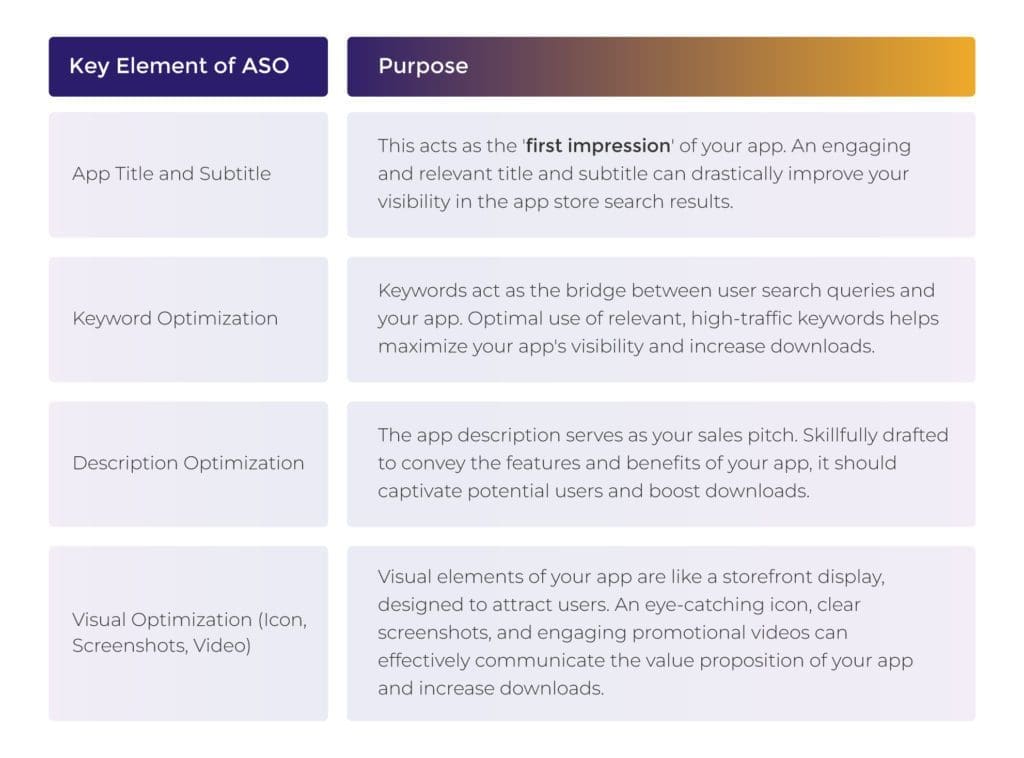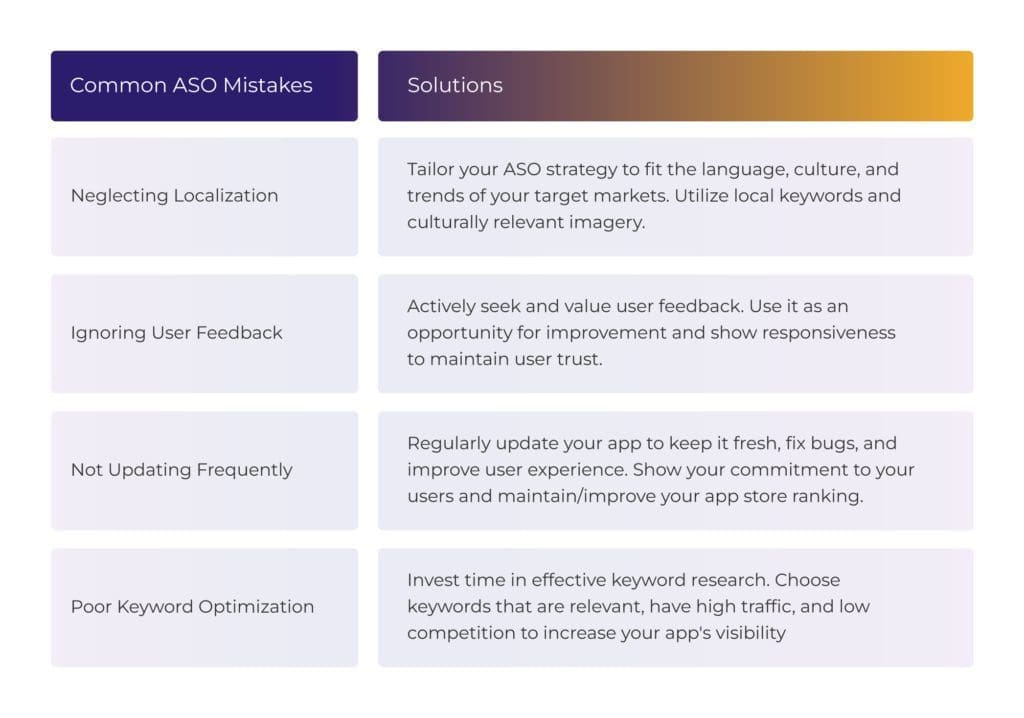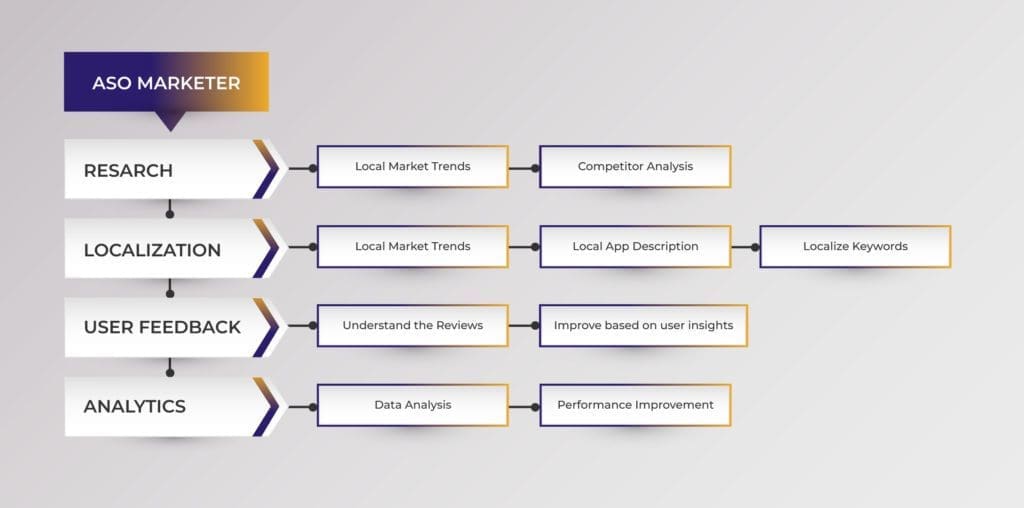In this guide, you’ll learn the key elements of ASO, understand its core metrics, learn step-by-step how to implement ASO and avoid common mistakes. We will conclude with expert tips and additional resources for further learning. Remember, the primary goal of ASO is to drive more downloads by optimizing crucial elements such as the app’s title, keywords, and description. Now, let’s dive a bit deeper into how this actually works and understand the basics of App Store Optimization!
Table of Contents
The Role of ASO for Businesses and Developers
Just like a shopkeeper places the most popular items at the front of the store to attract customers, ASO allows your app to be at the forefront, where potential users are most likely to see it. ASO is not a mere luxury but a necessity in today’s app-dominated landscape. With millions of apps competing for attention, an effective ASO strategy is vital to stand out, attract potential users, and ultimately, grow your app. Consider your ASO strategy like steering a ship: Regularly check your compass (app’s performance metrics) and adjust your course to stay on track. That’s at least what we like to say, here at Admiral Media.
Key Elements of App Store Optimization
The key to a successful App Store Optimization strategy is understanding which elements influence the app store rankings and optimizing them effectively. These elements include:
Capturing the Attention: App Title and Subtitle Optimization
The app title and subtitle are like your app’s handshake — they provide the first impression and help set the tone for what’s to come, these are the front runners of ASO. Being the first things potential users see, they play a pivotal role in making a powerful first impression. When optimized well, these elements can significantly improve search rankings and download rates.
The Power of Words: Keyword Optimization
Think of keywords as the magnets of your app — they attract potential users by connecting their search queries to your app. Therefore, keywords are essentially the backbone of ASO. They determine how users will find your app in the crowded app store. An effective keyword strategy involves using relevant, high-traffic, and low-competition keywords to maximize visibility and downloads.
Sell the Story: Description Optimization
Your app description is your sales pitch. It must convincingly convey the benefits and features of your app while incorporating keywords naturally. Remember, the key here is to engage the users, not the search engine.
Visuals Speak Volumes: Icon, Screenshots, and Video Optimization
Visual elements such as your app icon, screenshots, and promotional videos play a vital role in enticing users to download your app. Strive for visually compelling and informative graphics that effectively communicate your app’s value proposition. This area is very similar to having a conversion-optimized landing page for your website! 
Understanding App Store Optimization Metrics
Now let’s introduce you to the essential metrics in ASO that must be kept within sight. So, strap in and let’s start decoding!
The Popularity Contest: Number of Downloads
The number of downloads directly reflects your app’s popularity and can significantly influence its ranking in search results.
Public Opinion Matters: Ratings and Reviews
High ratings and positive reviews not only improve your app’s visibility but also act as social proof, influencing potential users’ download decisions. Getting more reviews for your app is a crucial part of App Store Optimization (ASO). Reviews not only provide valuable feedback but also improve your app’s visibility and credibility. Here are a few strategies to encourage users to review your app:
- In-app review prompts: Politely asking for reviews within the app can be very effective. However, it’s important to time these prompts appropriately. For example, after the user has completed a task or reached a milestone within the app.
- Incentivize reviews: Offer users something valuable in exchange for their review. This could be bonus features, additional content, or virtual goods.
- User support: Offer excellent user support and prompt responses to queries. When users feel heard and valued, they’re more likely to leave a review.
- Update frequently: Regular updates show users that you’re actively improving the app. After an update, users may be prompted to rate and review the app.
- Leverage your network: Encourage friends, family, and other networks to download and review the app. While it’s not a scalable strategy, it can be a good starting point to get initial reviews.
- Email and Social Media: If you have access to user emails (legally, of course), or you have an active social media following, you can use these channels to ask for reviews.
Remember, authenticity is key. Fake reviews can harm your reputation and are often removed by app store platforms. Encourage honest feedback and use it constructively to improve your app.
Engagement is Key: User Engagement
High user engagement — measured by metrics like session length, frequency of use, and in-app purchases — is indicative of your app’s success and can positively impact its ranking.
Stickiness Over Time: Retention and Churn Rate
The retention rate represents the percentage of users who return to your app, while the churn rate denotes those who uninstall. A healthy balance between high retention and low churn rates signifies a successful app.
A Roadmap to Success: Step-by-Step Guide to ASO
Fantastic! You’ve made it halfway through our journey into the world of App Store Optimization! By now, you’ve learned about what ASO is, its importance, the key elements you should optimize, and the metrics to keep an eye on. Pretty neat, right? But we’re not stopping here. Next, we will walk you through a practical, step-by-step guide to applying ASO to your app. 
Navigating the Pitfalls: Common Mistakes in ASO and How to Avoid Them
Kudos to you for making it this far into the realm of App Store Optimization (ASO)! Every adventure has its challenges, and ASO is no exception. In this upcoming section, we’re going to spotlight common pitfalls that can trip up even the best of us on our ASO journey. But fear not, we’re not just pointing out the traps — we’re also giving you the roadmap to navigate around them. So, let’s put on our explorer hats and learn how to sidestep these common ASO mistakes! Ignoring localization can hinder your app’s potential. Tailor your ASO strategy to fit your target markets’ language, culture, and trends. By catering to users in their native language, you’re not only expanding your reach but also fostering a positive user experience for your global customer base. This sense of familiarity and understanding cultivates trust in your brand and paves the way for a deeper connection with international audiences.
The Customer is Always Right: Ignoring User Feedback
User feedback provides invaluable insights to improve your app. Embrace negative reviews as opportunities for improvement and growth. 
Evolution, not Stagnation: Not Updating Frequently
Regularly updating your app shows commitment to your users and helps maintain or improve your app store rankings. 
Conclusion on our ASO guide
ASO: A Key to Mobile Success
By now, you should appreciate the significant role ASO plays in determining the success of your mobile app. A strategic and well-executed ASO plan can greatly boost your app’s visibility, downloads, and overall performance.
The ASO Journey: A Path of Continual Learning and Adaptation
Remember, ASO is an ongoing process, not a one-time event. Continual learning, adaptation, and optimization are essential to stay ahead of the competition. If you are serious about working with ASO – and want to scale your user acquisition, reach out to us through our contact form!






